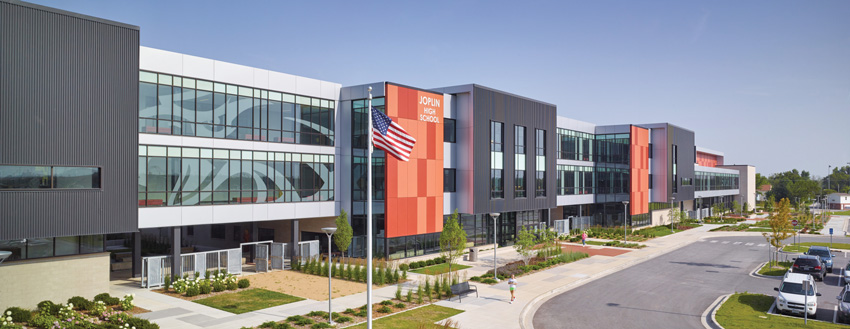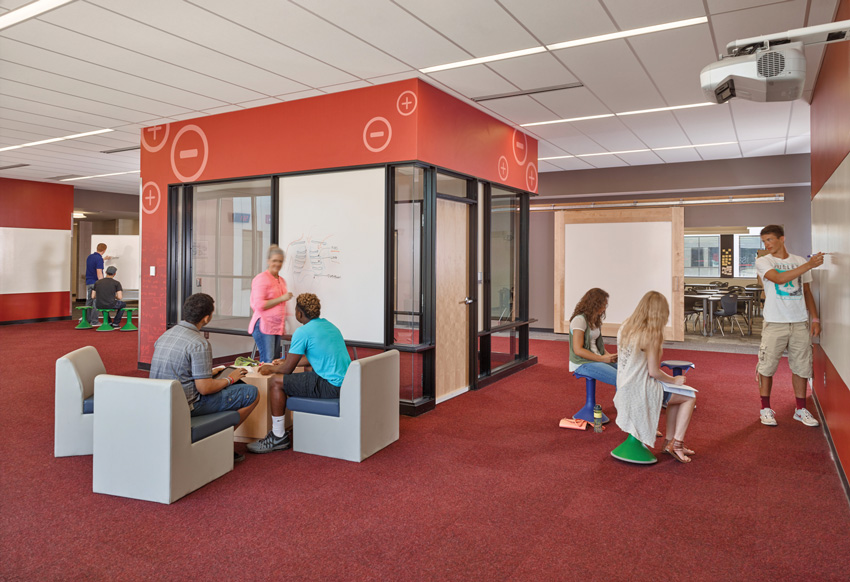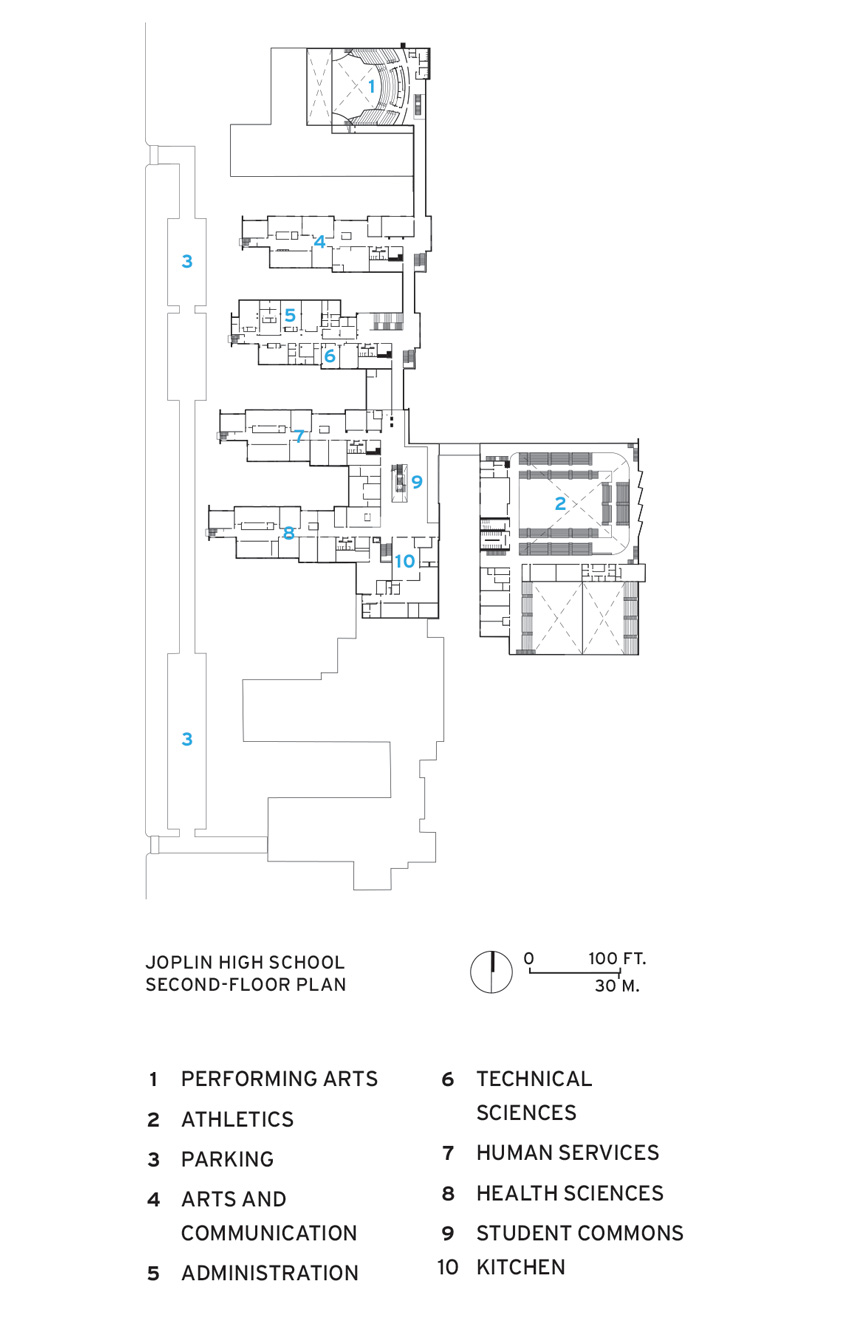School Safety and Security
Security is more than an absence of violence. In Joplin, Missouri, pre-design consultations for a new high school to replace one destroyed in a 2011 tornado made it clear that, although the disaster struck outside school hours, the devastation had left the students shaken. “They wanted to have a psychological sense that they were safe,” says Kevin Greischar, a principal at the Kansas City office of DLR Group, who designed the new school with local firm CGA Architects. As at Sandy Hook, security for the Joplin students didn’t mean a bunker. They wanted daylight, views, connections to the outdoors, and a school they felt proud to belong to.
The new 500,000-square-feet, 3,000-student high school maximizes light and transparency with generously sized windows, interior glazing, open spaces, and overlooks. In addition to the sense of uplift and security the light and openness provide, wood accents throughout the building contribute a sense of dignity, tactility, and warmth. Two iconic elements salvaged from the old school—stones from a rose garden and a bas relief brick eagle from the gym wall—provide a comforting continuity with the school’s pre-disaster days. As for future tornadoes, the $120 million school’s ground floor is bermed into the slope of the site, and program elements requiring solidity—such as a broadcasting studio, choral space, and counseling area—are designated to double as emergency shelters.
More common than the threat of either intruders or tornadoes, however, is conflict among students themselves. Children can be unkind to one another at any age, but by adolescence the hormone soup coursing through their veins, combined with high schools’ larger number of students and reduced levels of supervision, means that the most common source of security incidents is the kids themselves. A 2015 survey conducted by the Centers for Disease Control and Prevention on violence in high schools in the previous 12 months found that 8 percent of students had been in a fight at school, 6 percent had been threatened or injured with a weapon at school, and 20 percent had been bullied.
As evidence of the difference design can make, disciplinary incidents among students at Joplin’s new school, which opened in September 2014, dropped by more than 50 percent in its first year of operation, dropout rates fell by 25 percent, and the four-year graduation rate rose from 74 to 84 percent, as compared to the old school.
It was while the school was being accommodated in a temporary, post-tornado facility, also designed by DLR and CGA, that disciplinary incidents first began to drop. Staff realized that the old school’s attempt to control students by concentrating them in just a couple of common areas, including lunch in a single big cafeteria, had actually exacerbated conflict. And so they were open to a configuration at the new school that would distribute the students and reduce the apparent size of the school population in students’ day-to-day experience.



PHOTOGRAPHY: © ALISTAIR TUTTON, COURTESY CGA ARCHITECTS/DLR GROUP
NEIGHBORHOOD FEEL
To make Joplin, Missouri’s new 3,000-student high school (top) feel smaller, the architects organized the building into four three-story wings. These include classrooms clustered around adaptable break-out areas (middle).
The new school is organized into four three-story wings (plus performance and athletics spaces) opening off a central circulation spine, with each wing corresponding to a career pathway: Technical Sciences, Human Services, Arts and Communication, and Health Sciences. Classroom clusters on the upper floor of each wing group the students into small integrated-learning communities, each with their own break-out areas and social spaces, where students are free to eat lunch if they choose.
A similar risk triad of natural disaster, stranger danger, and student conflict influenced the design for Snoqualmie, Washing- ton’s new Mount Si High School, located in a long, narrow river valley east of Seattle—except here the risk of tornadoes is replaced with that of earthquakes and floods.
The site for the 350,000-square-foot replacement school, scheduled to open in 2019, will undergo major remediation to reduce the chances of liquefaction of its alluvial soil in a quake. The school itself will sit on a platform elevated 3 feet above the 100-year-flood level. As well as making for a more resilient school building, the raised platform improves security more narrowly defined, forming the first of four complementary strategies to foster security at the school. In CPTED terms, the raised platform clearly demarcates territory, presenting a psychological deterrent to potential offenders, and provides a view from the administrative area of anyone approaching the school.


IMAGES: COURTESY NAC ARCHITECTURE
STANDING TALL
The new Mount Si High School in Snoqualmie, Washington, will be raised on a platform 3 feet above the 100-year-flood level (top). The building will weave large-, medium-, and small-scale spaces together (bottom).
Designed to accommodate 2,300 students, with the capacity to expand to 2,800, Mount Si will be one of the largest high schools in Washington State. So the second strategy in the school’s design for security, as at Joplin, is to divide this population into smaller communities, including a separate building for first-year students. “They will know most, if not all, of the students inhabiting their home base,” says Boris Srdar—a principal in the Seattle office of NAC Architecture, designers of the school—“which automatically increases the perception of safety.” Breaking down the scale of the school into smaller, lockable buildings can also serve to delay a potential offender. And to alert staff and students to a security issue, a public address system with colored lights signaling different degrees of emergency enables communication with each classroom.
In the third strategy, large social spaces are also broken down and designed to invite gathering in smaller groups. The social spaces are configured as larger open areas complemented by a variety of smaller seating spaces along the perimeter, and this pattern is repeated on every floor in each of the academic buildings, to form an experiential fabric of large-, medium-, and small-scale spaces that weave the school together. “As students develop their own favorite places with their peers and friends,” says Srdar, “that contributes to their having a sense of choice and familiarity, and ultimately to feeling safer.”
For its fourth security strategy, the school’s design draws on biophilic principles, which account for humankind’s innate need for connection to nature. In particular, the design incorporates the biophilic patterns, or concepts, of prospect and refuge. The term prospect refers to the long views that humans instinctively enjoy and find reassuring, especially from an elevated position; while refuge refers to the sense of shelter or withdrawal, either from the elements or from action. Both patterns appeal to a basic instinct for what a safe place feels like, and multiple studies suggest they reduce stress. All of Mount Si’s social spaces enjoy views to the mountain for which the school is named, with a sense of refuge deriving from the cozy, protected character of the interior spaces.
At Mount Si, as at Sandy Hook and Joplin, the priorities for security and the values with which it needed to be integrated emerged from extensive community consultation and a careful consideration of the specifics of the site. Rather than handing security design over to security consultants, architects can play a pivotal role. “You have to translate these strict security requirements into a wonderful, nurturing environment for children to live and learn in,” says Brotman. “And if you keep everybody going back to the priorities, you’ll come to the best solution.”
Katharine Logan is an architectural designer and a writer focusing on design, sustainability, and well-being.








